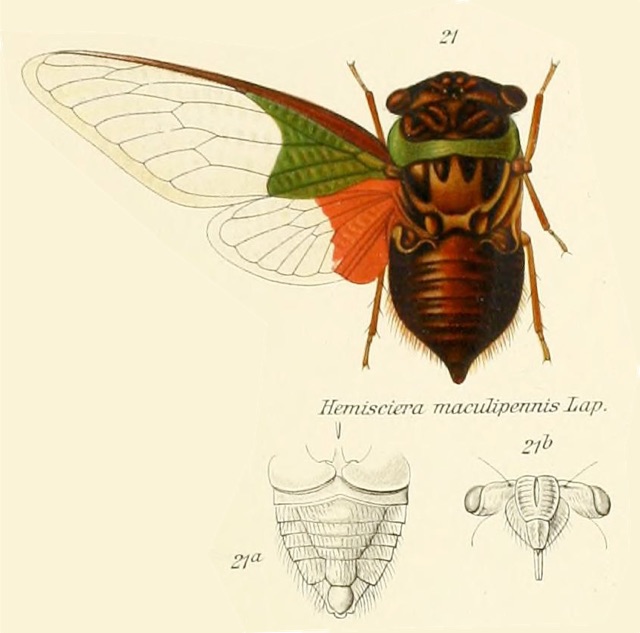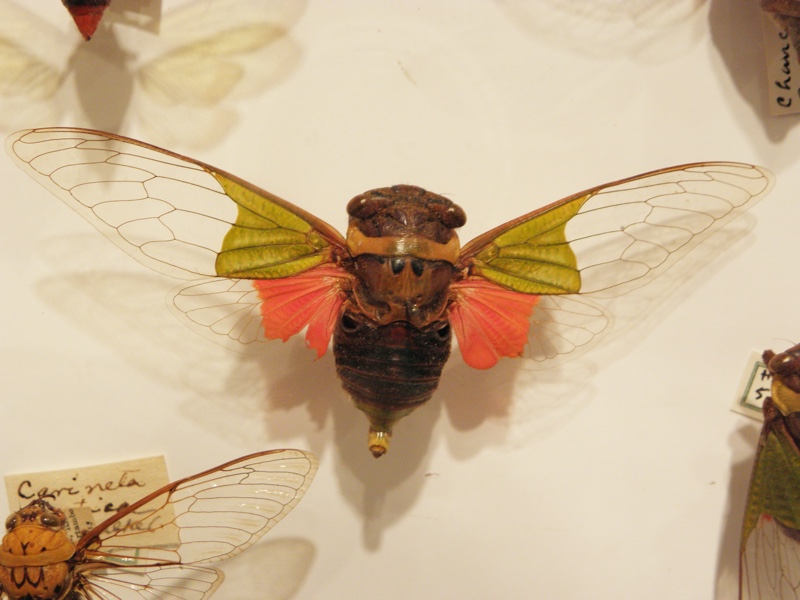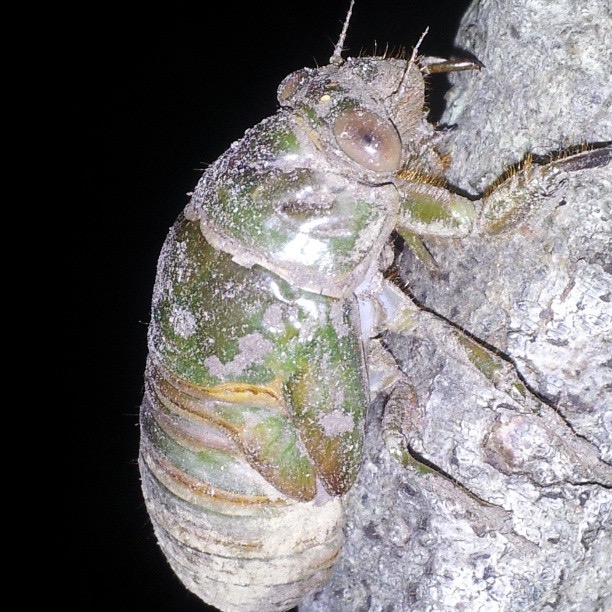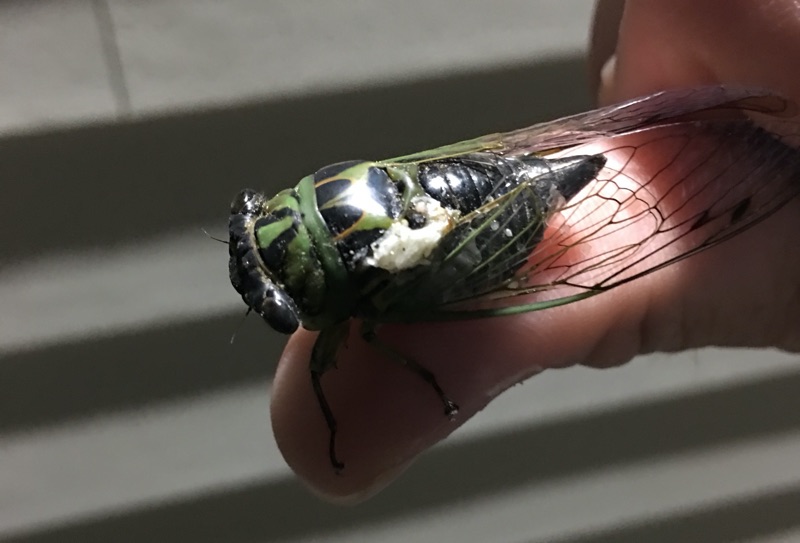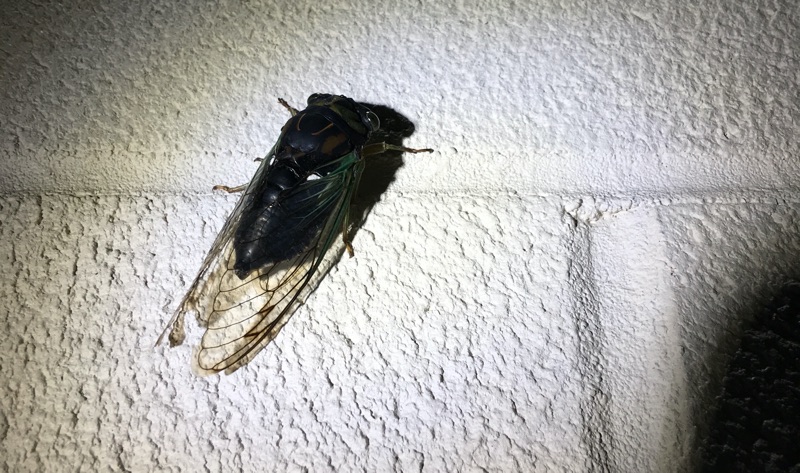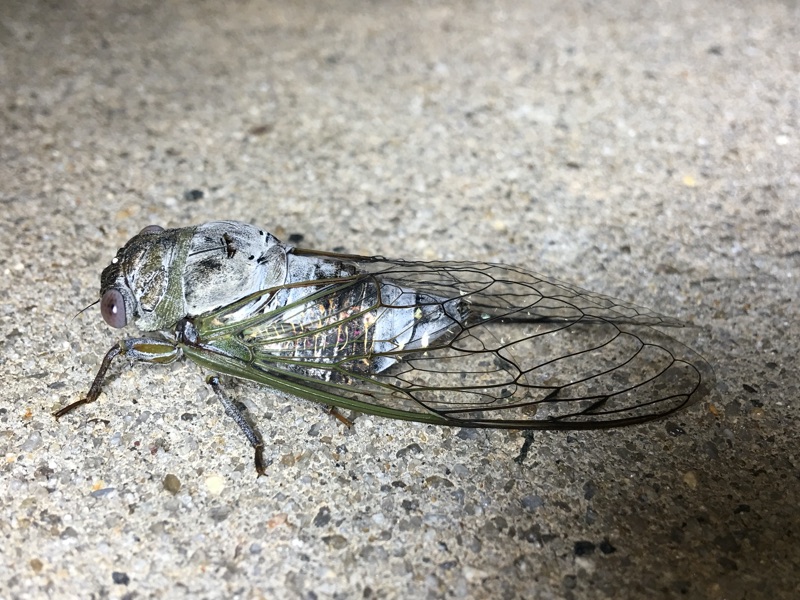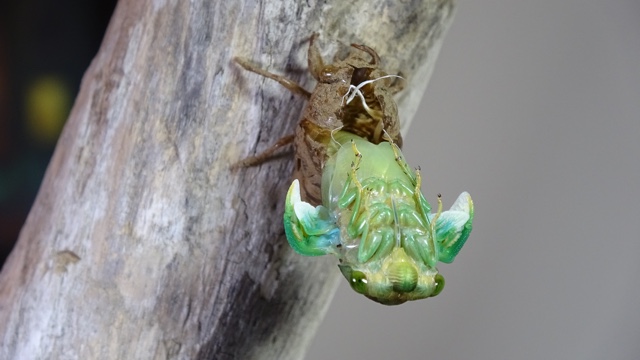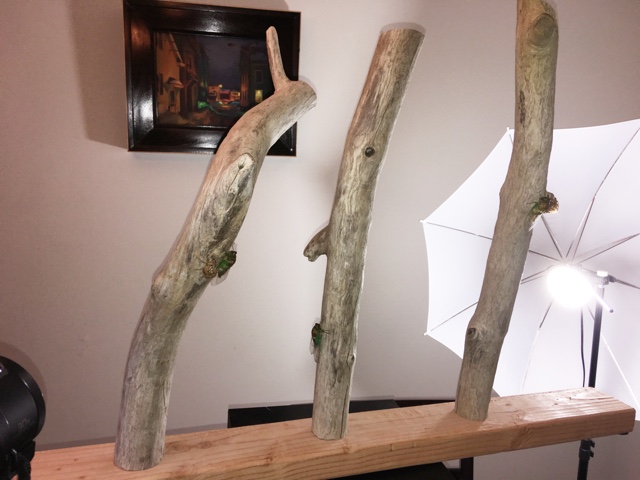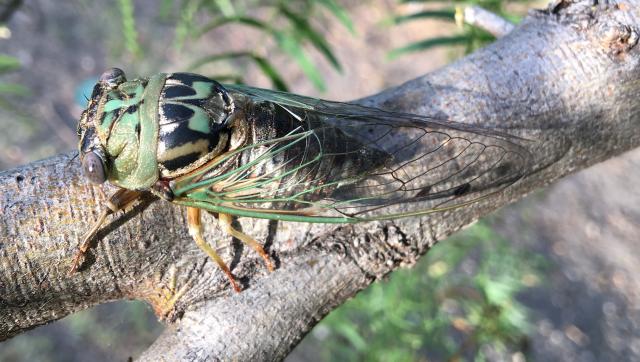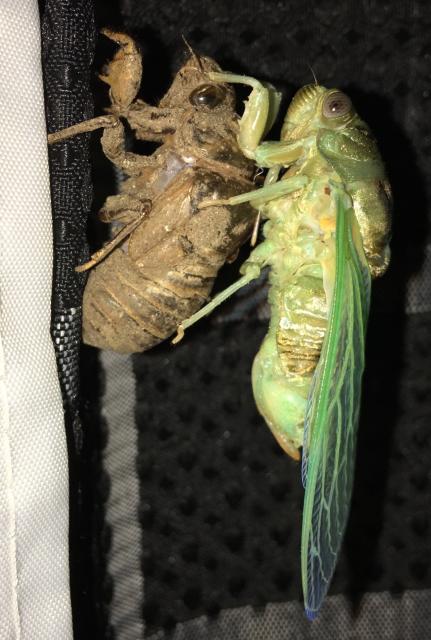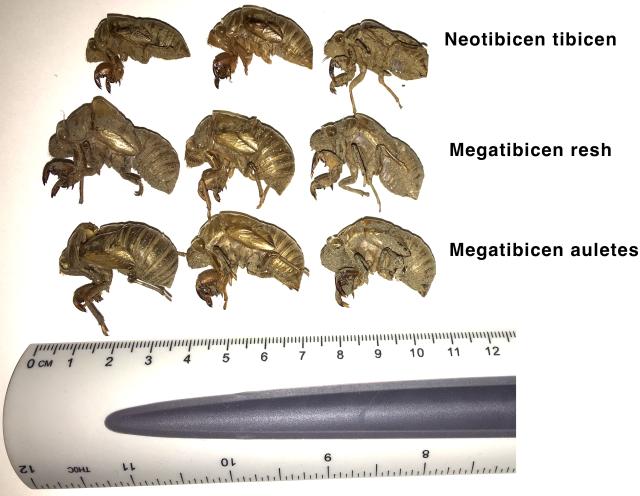| Cicada |
A |
M |
J |
J |
A |
S |
O |
Beameria venosa aka Aridland Cicada
AZ, AR, CO, IA, KS, MO, NE, NM, OK, TX, UT |
|
M |
J |
J |
A |
|
|
Beameria wheeleri
AZ, NM |
|
M |
J |
J |
|
|
|
Cacama valvata aka Common Cactus Dodger
AZ, CA, CO, KS, NV, NM, OK, TX, UT |
|
M |
J |
|
|
|
|
Cicadettana calliope calliope aka Southern Grass Cicada
AL, AR, CO, FL, GA, IL, IN, IA, KS, KY, LA, MD, MS, MO, NE, NC, OH, OK, SC, SD, TN, TX, VA |
|
|
J |
J |
A |
|
|
Cicadettana camerona
TX |
|
M |
J |
|
|
|
|
Cicadettana kansa
AZ, CO, KS, LA, NE, NM, OK, TX |
|
M |
J |
|
|
|
|
Cicadettana texana
TX |
|
M |
J |
|
|
|
|
Clidophleps vagans
AZ, CA, NV |
|
|
J |
|
|
|
|
Cornuplura nigroalbata
AZ |
|
|
|
|
|
|
|
Cornuplura rudis
Mexico |
|
M |
J |
J |
|
|
|
Diceroprocta apache aka Citrus Cicada
AZ, CA, CO, NV, UT |
|
|
J |
J |
A |
S |
|
Diceroprocta arizona
AZ |
|
|
|
|
|
|
|
Diceroprocta aurantiaca
NM, TX |
|
|
J |
|
|
|
|
Diceroprocta averyi
TX |
|
|
|
|
|
|
|
Diceroprocta azteca aka Scrub Cicada
KS, OK, TX |
|
|
|
J |
A |
|
|
Diceroprocta bequaerti
AL, AR, LA, MS, OK, TX |
|
|
|
|
|
|
|
| Diceroprocta biconicaFL, Cuba |
|
|
|
|
|
|
|
Diceroprocta bicosta
Mexico |
|
|
|
|
|
|
|
Diceroprocta crucifera
Mexico |
|
|
|
|
|
|
|
Diceroprocta eugraphica
AZ, CO, KS, NM, OK, TX |
|
|
J |
J |
|
|
|
Diceroprocta knighti
AZ, Mexico |
|
|
J |
J |
|
|
|
Diceroprocta marevagans
TX |
|
|
|
J |
A |
S |
|
Diceroprocta olympusa aka Olympic Scrub Cicada
AL, FL, GA, MS, NC, SC |
|
|
J |
J |
|
|
|
Diceroprocta ornea
Mexico |
|
|
|
|
|
|
|
Diceroprocta psophis
Mexico |
|
|
|
|
|
|
|
Diceroprocta ruatana
Honduras |
|
|
|
|
|
|
|
Diceroprocta semicincta
AZ, NM |
|
|
J |
J |
|
|
|
Diceroprocta swalei swalei
AZ |
|
|
J |
|
|
|
|
Diceroprocta texana
TX, NM |
|
|
J |
J |
A |
|
|
Diceroprocta vitripennis aka Green Winged Cicada
AL, AR, IL, IN, KS, KY, LA, MI, MS, MO, NE, OK, TN, TX, WI |
|
|
J |
J |
A |
|
|
Hadoa bifida
AZ, CO, KS, NM, OK, TX, UT |
|
M |
J |
J |
|
|
|
Hadoa chiricahua
AZ, NM |
|
M |
J |
J |
A |
|
|
Hadoa duryi
AZ, CO, NM, OK, TX, UT |
|
M |
J |
J |
A |
|
|
Hadoa inaudita
AZ, CO, NM, OK, TX |
|
|
J |
J |
A |
|
|
Hadoa longiopercula
AZ |
|
|
|
|
|
|
|
Hadoa parallela
AZ |
|
|
|
J |
A |
S |
|
Hadoa simplex
AZ |
|
M |
J |
|
|
|
|
Hadoa texana
NM, OK, TX |
|
|
J |
J |
A |
S |
|
Hadoa townsendii
AZ, NM, TX |
|
M |
J |
|
|
|
|
Magicicada cassinii aka Cassini 17-Year Cicada*
GA, IA, IL, IN, KS, KY, MD, MO, NC, NE, NJ, NY, OH, OK, PA, TN, TX, VA, WI, WV |
|
M |
J |
|
|
|
|
Magicicada neotredecim*
AR, IA, IL, IN, KY, MO, TN |
|
M |
J |
|
|
|
|
Magicicada septendecim aka Linnaeus’s 17-Year Cicada*
CT, DC, DE, GA, IA, IL, IN, KS, KY, MA, MD, MI, MO, NC, NE, NJ, NY, OH, PA, RI, SC, TN, VA, WI, WV |
|
M |
J |
|
|
|
|
Magicicada septendecula*
GA, IA, IL, IN, KS, KY, MO, NC, NJ, NY, OH, OK, PA, TN, VA, WV |
|
M |
J |
|
|
|
|
Magicicada tredecassini*
AL, AR, GA, IA, IL, IN, KY, MD, MO, MS, NC, OH, OK, SC, TN, VA |
|
M |
J |
|
|
|
|
Magicicada tredecim*
AL, AR, GA, IL, IN, KY, LA, MD, MO, MS, NC, OH, OK, SC, TN, VA |
|
M |
J |
|
|
|
|
Magicicada tredecula*
AL, AR, GA, IA, IL, IN, KY, LA, MO, MS, NC, OH, OK, SC, TN, VA |
|
M |
J |
|
|
|
|
Megatibicen grossus aka Northern Dusk Singing Cicada
AL, AR, CT, DE, DC, FL, GA, IL, IN, IA, KS, KY, LA, MD, MA, MI, MS, MO, NE, NJ, NY, NC, OH, OK, PA, SC, TN, TX, VA, WV, WI |
|
|
|
J |
A |
S |
O |
Megatibicen cultriformis aka Grand Western Flood Plain Cicada
AZ, NM, CA |
|
|
|
|
A |
S |
O |
Megatibicen dealbatus aka Plains Cicada
CO, IA, KS, MT, NE, NM, ND, OK, SD, TX, WY |
|
|
|
J |
A |
S |
|
Megatibicen dorsatus aka Giant Grassland Cicada
AR, CO, ID, IL, IA, KS, MO, MT, NE, NM, OK, SD, TX, WY |
|
|
|
J |
A |
S |
|
Megatibicen figuratus aka Fall Southeastern Dusk-singing Cicada
AL, AR, FL, GA, LA, MS, NC, SC, TN, TX, VA |
|
|
|
|
A |
S |
O |
Megatibicen harenosus
NM, TX |
|
|
|
|
A |
S |
|
Megatibicen pronotalis pronotalis
IA, MO, NE, ND, OK, SD |
|
|
|
|
A |
S |
O |
Megatibicen pronotalis walkeri aka Walker’s Cicada
AL, AR, FL, GA, IL, IN, IA, KS, KY, LA, MD, MI, MN, MS, MO, NE, NC, ND, OH, OK, SD, TN, TX, VA, WV, WI, and WY |
|
|
|
|
A |
S |
O |
Megatibicen resh aka Resh Cicada
AR, KS, LA, MS, NE, OK, SC, TN, TX |
|
|
|
J |
A |
S |
|
Megatibicen resonans aka Southern Resonant Cicada
AL, FL, GA, LA, MS, NC, SC, TN, TX, VA |
|
|
J |
J |
A |
S |
O |
Megatibicen tremulus aka Cole’s Bush Cicada
CO, KS, NE, OK, TX |
|
|
J |
J |
A |
S |
|
Neocicada chisos
TX |
A |
M |
|
|
|
|
|
Neocicada hieroglyphica aka Hieroglyphic Cicada
AL, AR, DE, FL, GA, IL, IN, KS, KY, LA, MD, MS, MO, NJ, NY, NC, OH, OK, SC, TN, TX, VA |
|
M |
J |
J |
A |
|
|
Neocicada hieroglyphica johannis
FL |
|
M |
J |
J |
|
|
|
Neoplatypedia constricta
AZ, CA, CO, ID, NV, NM, OR, UT |
|
M |
J |
J |
|
|
|
Neotibicen auriferus aka Plains Dog-day Cicada
AR, KS, MO, NE, NM, OK, TX |
|
|
|
|
A |
S |
|
Neotibicen canicularis aka Dog-day Cicada
AR, CT, DC, IL, IN, IA, KS, ME, MB, MD, MA, MI, MN, MO, NE, NB, NH, NJ, NY, NC, ND, NS, OH, ON, PA, PE, QC, RI, SC, SD, TN, VT, VA, WV, WI |
|
|
|
J |
A |
S |
|
Neotibicen davisi aka Davis’ Southeastern Dog-Day Cicada
AL, DE, DC, FL, GA, LA, MD, MA, MS, NJ, NY, NC, PA, SC, TN, TX, VA, WV |
|
|
|
|
A |
S |
O |
Neotibicen latifasciatus aka Coastal Scissors Grinder Cicada
FL, MD, NJ, NC, VA |
|
|
|
J |
A |
S |
O |
Neotibicen linnei aka Linne’s Cicada
AL, AR, CT, DE, DC, FL, GA, IL, IN, IA, KS, KY, LA, ME, MD, MA, MI, MN, MS, MO, NE, NJ, NY, NC, OH, ON, PA, SC, TN, VT, VA, WV, WI |
|
|
|
J |
A |
S |
|
Neotibicen lyricen engelhardti aka Dark Lyric Cicada
AL, CT, DE, DC, FL, GA, IN, IL, KY, MD, MA, MS, NJ, NY, NC, OH, PA, RI, SC, TN, VA, WV |
|
|
|
J |
A |
S |
|
Neotibicen lyricen lyricen aka Lyric Cicada
AL, AR, CT, DE, DC, FL, GA, IL, IN, IA, KS, KY, LA, MD, MA, MI, MS, MO, NE, NH, NJ, NY, NC, OH, OK, ON, PA, RI, SC, TN, TX, VA, WV, WI |
|
|
J |
J |
A |
|
|
Neotibicen lyricen virescens aka Costal Lyric Cicada
FL, GA, NC, SC |
|
|
J |
J |
A |
S |
O |
Neotibicen pruinosus pruinosus aka Scissors Grinder
AL, AR, CO, IL, IN, IA, KS, KY, LA, MI, MN, MS, MO, NE, NC, OH, OK, PA, SC, SD, TN, TX, WV, WI |
|
|
J |
J |
A |
S |
O |
Neotibicen robinsonianus aka Robinson’s Cicada
AL, AR, DC, FL, GA, IL, IN, KS, MD, MS, MO, NC, OH, PA, TN, TX, VA, WI |
|
|
J |
J |
A |
S |
O |
Neotibicen similaris apalachicola
FL, AL, GA |
|
|
J |
J |
A |
S |
O |
Neotibicen similaris similaris aka Similar Dog-Day Cicada
AL, FL, GA, LA, MS, NC, SC |
|
|
J |
J |
A |
S |
O |
Neotibicen superbus aka Superb Dog-Day Cicada
AR, KS, LA, MO, NM, OK, TX |
|
|
J |
J |
A |
|
|
Neotibicen tibicen australis aka Southern Swamp Cicada
AL, FL, GA, MS, NC, SC, TN, VA |
|
|
J |
J |
A |
S |
|
Neotibicen tibicen tibicen aka Morning Cicada
AL, AR, CT, DE, DC, FL, GA, IL, IN, IA, KS, KY, LA, MD, MA, MI, MS, MO, NE, NJ, NY, NC, OH, OK, PA, RI, SC, SD, TN, TX, VT, VA, WV, WI |
|
|
J |
J |
A |
S |
|
Neotibicen winnemanna aka Eastern Scissors Grinder
DE, DC, GA, MD, NC, NJ, PA, SC, VA |
|
|
J |
J |
A |
|
|
Okanagana balli**
IL, IA, KS, MN, NE, ND, SD, WI |
|
|
J |
J |
|
|
|
Okanagana bella aka Mountain Cicada**
AB, AZ, BC, CA, CO, ID, MT, NV, NM, OR, SD, UT, WA, WY |
|
|
J |
J |
|
|
|
Okanagana canadensis aka Canadian Cicada**
AB, BC, CA, CO, ID, ME, MB, MI, MN, MT, NB, NH, NY, NT, OH, ON, OR, PA, QC, SK, SD, UT, VT, WI |
|
|
J |
J |
|
|
|
Okanagana fumipennis**
AZ, CO, NM, UT |
|
M |
J |
J |
|
|
|
Okanagana hesperia**
AZ, CA, CO, KS, MT, NE NV, NM, OK, SD, TX, UT, WY |
|
|
J |
J |
|
|
|
Okanagana rimosa rimosa aka Say’s Cicada**
AB, BC, CA, CT, ID, IL, IN, IA, ME, MB, MD, MA, MI, MN, MT, NV, NB, NH, NJ, NY, ND, OH, ON, OR, PA, QC, SD, UT, VT, VA, WA, WI, WY |
|
M |
J |
J |
|
|
|
Okanagana synodica synodica aka Walking Cicada**
AB, AZ, CA, CO, IA, KS, MO, MT, NE, NM, ND, OK, OR, SD, TX, UT, WY |
|
|
J |
J |
|
|
|
Okanagana utahensis**
AZ, BC, CA, CO, ID, MT, NV, NM, OR, UT, WA |
|
M |
J |
J |
|
|
|
Okanagana vanduzeei**
BC, CA, ID, NV, OR, UT, WA |
|
|
J |
J |
|
|
|
Okanagana viridis aka Cotton Green Cicada**
AR, LA, MS, TX |
|
|
J |
J |
|
|
|
Pacarina puella aka Little Mesquite Cicada
AZ, LA, OK, TX |
|
M |
J |
J |
|
|
|
Platypedia putnami putnami**
AZ, BC, CA, CO, ID, MT, NE, NV, NM, OR, SD, UT, WA,WY |
|
M |
J |
J |
|
|
|
Platypedia similis**
CA, OR |
A |
M |
|
|
|
|
|
Quesada gigas (Olivier, 1790) aka Giant Cicada
TX, Mexico |
A |
M |
J |
|
|
|
|
Cicada by State:
Alabama, Arizona, Arkansas, California, Colorado, Connecticut, Delaware, Florida, Georgia, Idaho, Illinois, Iowa, Indiana, Kansas, Kentucky, Louisiana, Maine, Maryland, Massachusetts, Michigan, Minnesota, Mississippi, Missouri, Montana, Nebraska, Nevada, New Hampshire, New Jersey, New Mexico, New York, North Carolina, North Dakota, Ohio, Oklahoma, Oregon, Pennsylvania, Rhode Island, South Carolina, South Dakota, Tennessee, Texas, Utah, Vermont, Virginia, Washington, West Virginia, Wisconsin, Wyoming.
Cicadas by Canadian Provence:
Alberta, British Columbia, Manitoba, New Brunswick, Nova Scotia, Northwest Territories, Ontario, Prince Edward Island, Quebec, Saskatchewan.
Northern Hemisphere:
Brunei, Cambodia, Cameron, Canada, Central African Republic, China, Colombia, Costa Rica, Croatia, Cuba, Cyprus, Dominican Republic, England, Egypt, France, French Guiana, Guatemala, Guyana, Honduras, India, Italy, Japan, Laos, Mexico, Myanmar (Burma), Nepal, Nicaragua, Nigeria, Panama, Philippines, Qatar, Romania, Singapore, Slovenia, Spain, Sri Lanka, Taiwan, Tanzania, Thailand, Turkey, United States, Vietnam, Venezuela
Equatorial:
Brazil, Colombia, Democratic Republic of the Congo, Ecuador, Indonesia
Southern Hemisphere:
Argentina, Australia, Bolivia, Botswana, Fiji, Lesotho, Madagascar, Malaysia, Namibia, New Zealand, Papua New Guinea, Paraguay, South Africa, Solomon Islands, Zimbabwe
World Wide Cicada Websites:
Periodical cicada forecasts:
There are two known species of periodical cicadas that are not Magicicada . One lives in Chremistica ribhoi in India and the other in Raiateana knowlesi in Fiji.
| YEAR! |
Chremistica ribhoi in India |
Raiateana knowlesi in Fiji |
Magicicada in the U.S. |
| 2024 |
Leap Year brood |
|
Brood XIX, Brood XIII |
| 2025 |
|
YES |
Brood XIV |
| 2026 |
World Cup brood |
|
|
| 2027 |
|
|
Brood XXII |
| 2028 |
Leap Year brood |
|
Brood XXIII |
| 2029 |
|
|
Brood I |
| 2030 |
World Cup brood |
|
Brood II |
| 2031 |
|
|
Brood III |
| 2032 |
Leap Year brood |
|
Brood IV |
| 2033 |
|
YES |
Brood V |
| 2034 |
World Cup brood |
|
Brood VI |
| 2035 |
|
|
Brood VII |
| 2036 |
Leap Year brood |
|
Brood VIII |
| 2037 |
|
|
Brood IX, Brood XIX |
| 2038 |
World Cup brood |
|
Brood X |
| 2039 |
|
|
|
| 2040 |
Leap Year brood |
|
|
| 2041 |
|
YES |
Brood XIII |
Cicada Tribes 2:
Arenopsaltriini, Carinetini, Cicadatrini, Cicadettini, Cicadini, Cosmopsaltriini, Tacuini (Cryptotympanini), Cyclochilini, Dundubiini, Fidicinini, Gaeanini, Hyantiini, Lahudadini, Lamotialnini, Leptopsaltriini, Macrotristriini, Oncotympanini, Parnisini, Platypediini, Platypleurini, Polyneurini, Psaltodini, Psithyristriini, Sonatini, Talaingini, Taphurini, Tettigadini, Thophini, Tibicinini, Tosenini, Zammarini
Cicada Genera:
Afzeliada, Aleeta, Ambragaeana, Amphipsalta, Anapsaltoda, Angamiana, Antankaria, Arenopsaltria, Ariasa, Arunta, Auritibicen, Ayesha, Ayuthia, Balinta, Basa, Beameria, Becquartina, Berberigetta, Cacama, Calliopsida, Callogaeana, Calyria, Carineta, Champaka, Chlorocysta, Chonosia, Chremistica, Chrysolasia, Cicada, Cicadatra, Cicadetta, Cicadettana, Cicadmalleus, Clidophleps, Clinopsalta, Cornuplura, Cosmopsaltria, Cryptotympana, Cyclochila, Cystosoma, Daza, Derotettix, Diceroprocta, Diceropyga, Diemeniana, Distantalna, Dorachosa, Dorisiana, Dundubia, Euryphara, Euterpnosia, Fidicina, Fidicinoides, Formotosena, Gaeana, Graptopsaltria, Hadoa, Hamza, Haphsa, Hemisciera, Heteropsaltria, Hilaphura, Huechys, Hyalessa, Ioba, Kamalata, Kikihia, Koma, Kongota, Lahugada, Lembeja, Leptopsaltria, Lethama, Lyristes, Macrosemia, Macrotristria, Magicicada, Majeorona, Maoricicada, Mata, Maua, Megapomponia, Megatibicen, Meimuna, Miranha, Mogannia, Muansa, Munza, Myopsalta, Neocicada, Neoplatypedia, Neopsaltoda, Neotibicen, Odopoea, Okanagana, Okanagodes, Ollanta, Oncotympana, Orialella, Orientopsaltria, Pacarina, Pachypsaltria, Pauropsalta, Platylomia, Platypedia, Platypleura, Polyneura, Pomponia, Proarna, Procollina, Psaltoda, Psithyristria, Purana, Pycna, Quesada, Raiateana, Salvazana, Semia, Sulphogaeana, Tacua, Talainga, Tanna, Taona, Terpnosia, Tettigades, Tettigarcta, Tettigettalna, Thopha, Tibicen, Tibicina, Tibicinoides, Tosena, Trengganua, Tugelana, Tympanoterpes, Uhleroides, Umjaba, Yanga, Yezoterpnosia, Yoyetta, Zammara
